Autumn is an excellent time to plant edible bulbous plants in the kitchen garden or allotment for harvesting next year. The shining example is garlic – that culinary staple beloved of most home cooks and prized worldwide as much for its health-boosting qualities as for its distinctively pungent, spicy flavour.
One of the best reasons to grow your own garlic is, of course, to avoid buying those suspiciously pristine supermarket bulbs shipped vast distances from China (the world's largest producer) or other far-flung countries so that they come with the carbon footprint of Meghan Markle. Another is the opportunity it provides to explore the subtle differences between varieties of garlic in terms of strength and flavour. Some of these are categorised as "hardneck", others "softneck"; the former are hardier, more strongly flavoured and produces flower spikes and fatter but have fewer cloves around a central stem. The latter produces more but smaller cloves, does not flower but stores better and is less tolerant of long, cold winters.
Both types need a sustained period of gentle winter cold – one to two months at a temperature between zero and 10 degrees – for the bulbs to plump up. Garlic also likes time to acclimatise into warm autumn soil before temperatures plunge. October to mid-November is an excellent time to plant the fleshy cloves.
The first rule of good garlic growing is to source large, fresh, healthy and unblemished bulbs from a reputable supplier, to avoid accidentally introducing common diseases into your plot
But first a few tips. The first rule of good garlic growing, an important one, is to source large, fresh, healthy and unblemished bulbs from a reputable supplier to avoid accidentally introducing common diseases such as onion white rot into your plot. For the same reason as well as for the fact that it's not necessarily a variety suitable for cultivation in Ireland, resist the temptation to plant cloves of supermarket-purchased bulbs. Crop rotation is also key to avoiding pests and diseases, so avoid planting into ground where you've recently grown another member of the allium family such as leeks or onions.
For happy, healthy, productive plants, give them a very sunny, open spot and free-draining but fertile, weed-free soil. To boost fertility, add some well-rotted garden compost and a few handfuls of pelleted organic fertilizer a week or so before planting but remember that as a member of the allium family, garlic doesn’t like a freshly-manured soil. If your’s is very acidic, it’s also worth adding a light sprinkle of garden lime while adding a scattering of wood ash before planting will also help boost potash levels.
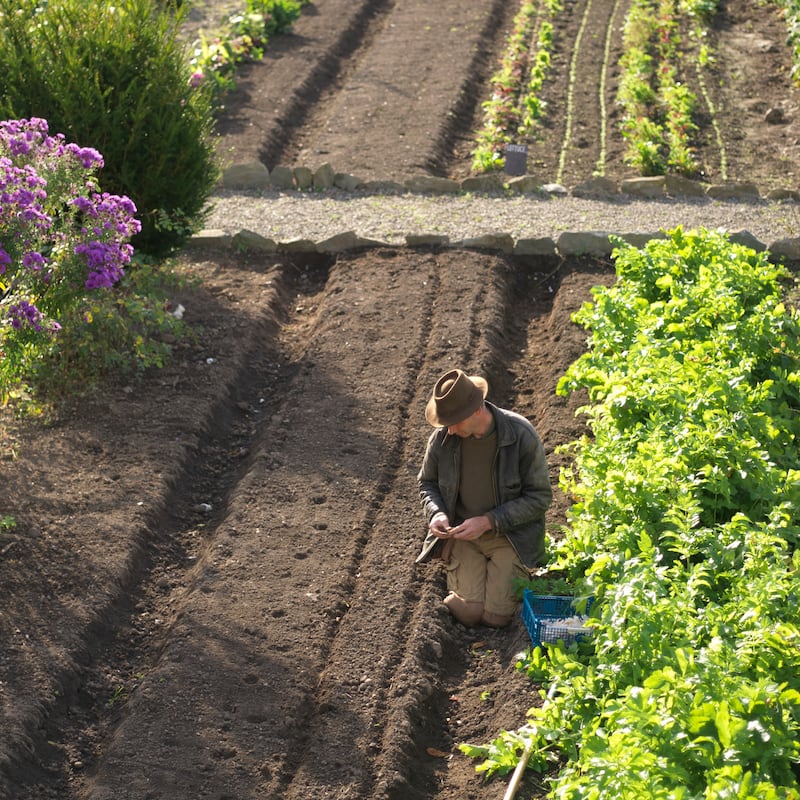
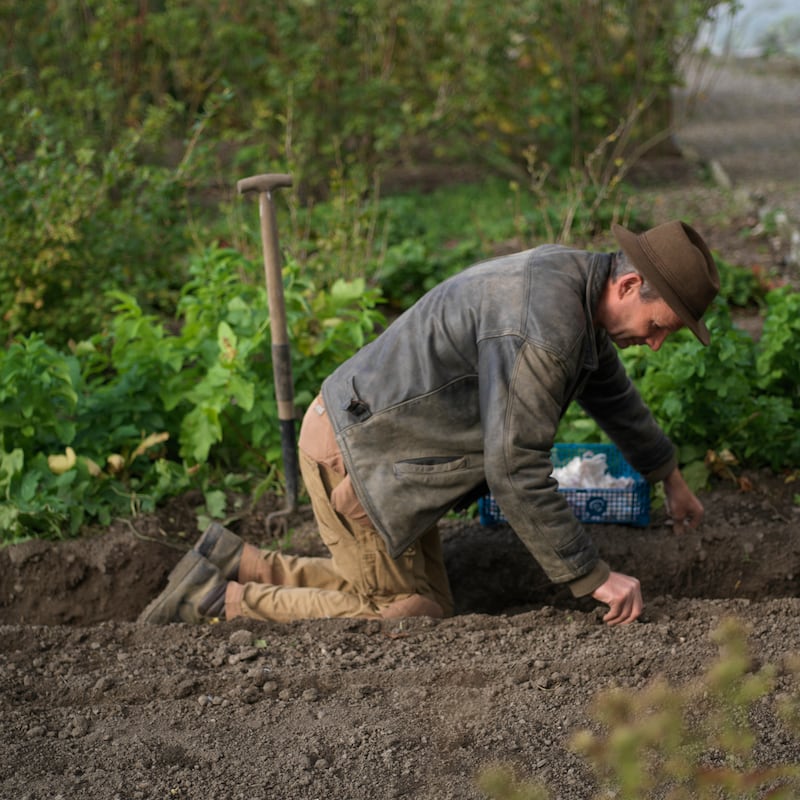
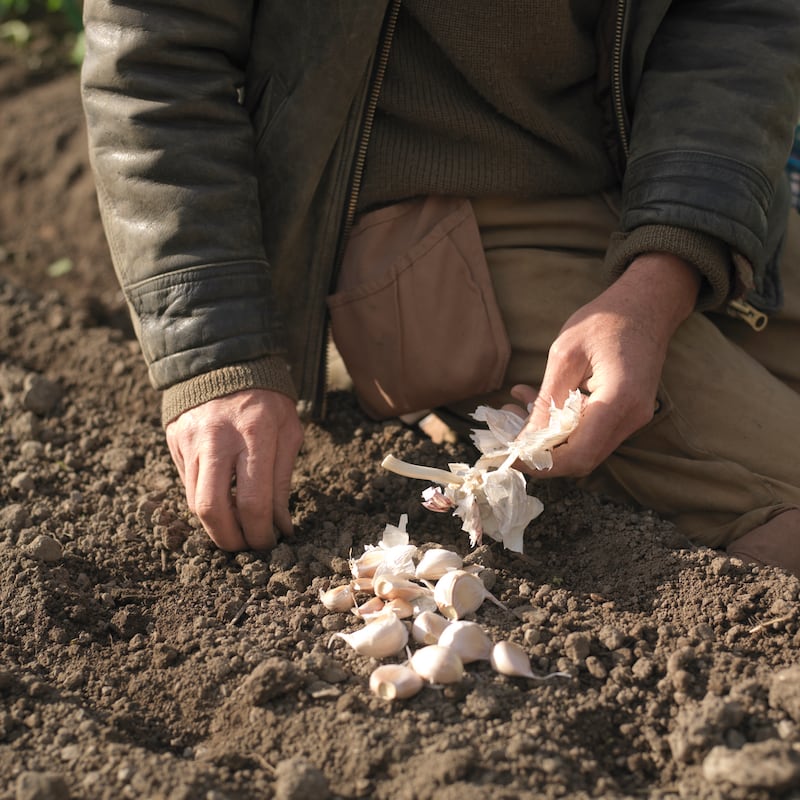
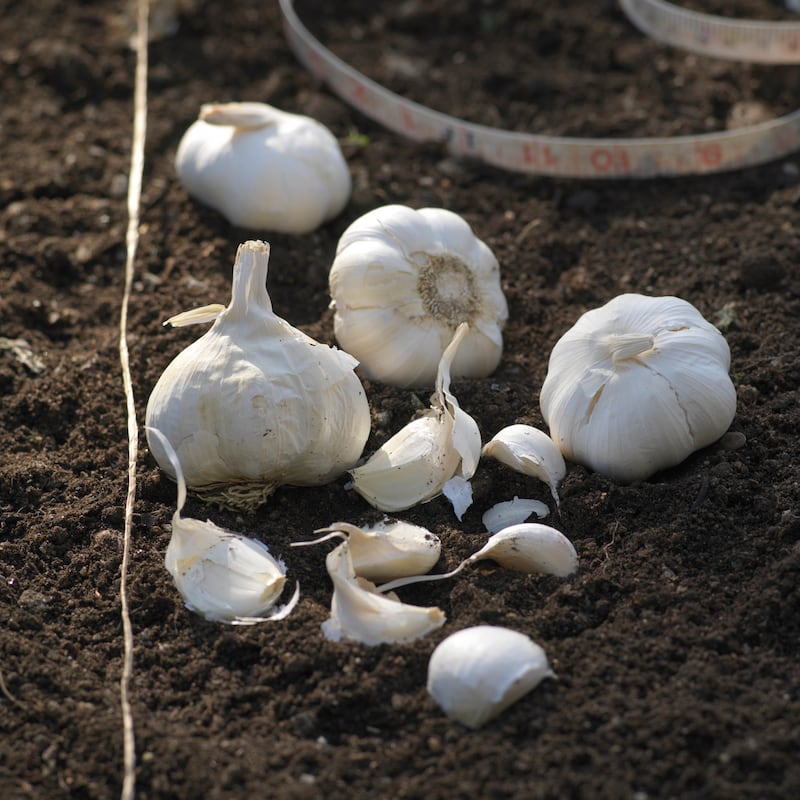
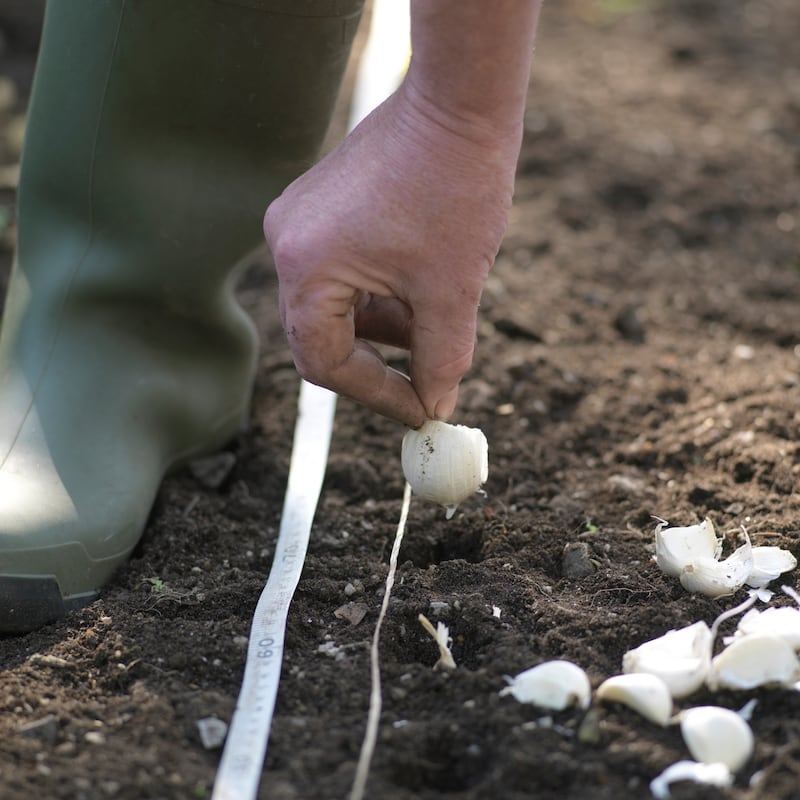
In gardens or allotments prone to winter wetness, it’s best to plant into slightly raised drills/ridges or raised beds lightened with some horticultural grit to help with drainage as garlic hates to sit in cold, damp soil. In very wet gardens, plant into modules for transplanting into the ground in spring when soil conditions typically improve. Alternatively, where growing space is very tight garlic can be successfully grown in a pot/container/window box just as long as it’s at least 20cm deep and 15cm wide to allow for good root establishment.
Just before planting you’ll need to gently separate each bulb into its individual cloves or bulb segments (one bulb will contain between 5-10 cloves depending on the particular variety), leaving their protective papery skins intact. The larger the clove, the larger the bulb it will eventually produce so when growing space is limited, plant only the larger cloves (this way you get nice, large, plump bulbs) and keep the smallest ones for cooking.
Each bulb segment should be buried to at least twice its depth (so that there’s about 2.5-5cm of soil above it) with its pointy-tip upwards and its flattened basal plate (the part of the clove from which the roots grow) to the bottom. On very fertile, free-draining soils, you can plant as deeply as 10cm to give a better harvest. Make sure to handle the delicate, fleshy garlic cloves very gently at this stage (rough treatment can cause poor root growth), spacing them out so that there’s 10cm-20cm between each clove and 30cm between rows. Finish off by marking the rows clearly with a label so that you don’t accidentally damage the baby bulbs while weeding/hoeing, something that’s horribly easy to do.
Nip out any flowers, or scrapes, before they develop, to keep their energy for the bulbs, but don't throw them on the compost heap: they're delicious added to a stir-fry or salad
By early December, you should see the first green shoots poking up through the soil. Come late winter/early spring, give the plants a liquid seaweed feed and another light sprinkle of wood ash around the soil. A shallow mulch of garden compost or grass clippings will also help keep the ground free of weeds. By mid-spring, flowers or “scapes” may start emerging on some of the hardneck varieties. Nip these out before they develop to prevent them taking energy away from the swelling bulbs but don’t throw them on the compost heap; instead they’re delicious added to a stir-fry or a salad.
In an unusually dry spring like the one we experienced this year, it’s also important to keep the swelling bulbs regularly watered. By mid-summer/August, the leaves of your autumn-sown garlic will start to yellow, a sign that it’s ready to be harvested. If it’s a soft-neck variety, the leaves will also start to droop. Choose a dry day to gently dig the bulbs up (keep the leaves on them) and place them in a glasshouse, polytunnel, well-ventilated garden shed or sunny porch for a couple of weeks to dry. Once dry, they can be stored somewhere cool and dry to help keep them as fresh and flavoursome as possible.
Recommended varieties of garlic that can be autumn-planted include Vallelado, Red Duke, Lautrec Rose, Lautrec Wight (fantastic flavour but only suitable for sheltered gardens with very well-drained soils) and Chesnok Red (all hardneck types), as well as softneck types such as Germidour Arno, Marco, Thermidrome , Messidrome, Solent Wight and Christo. Seed garlic is available from all good garden centres at this time of year, as well as from specialist suppliers, including West Cork Garlic, QuickCrop, Fruithill Farm and the UK-based Garlic Farm.
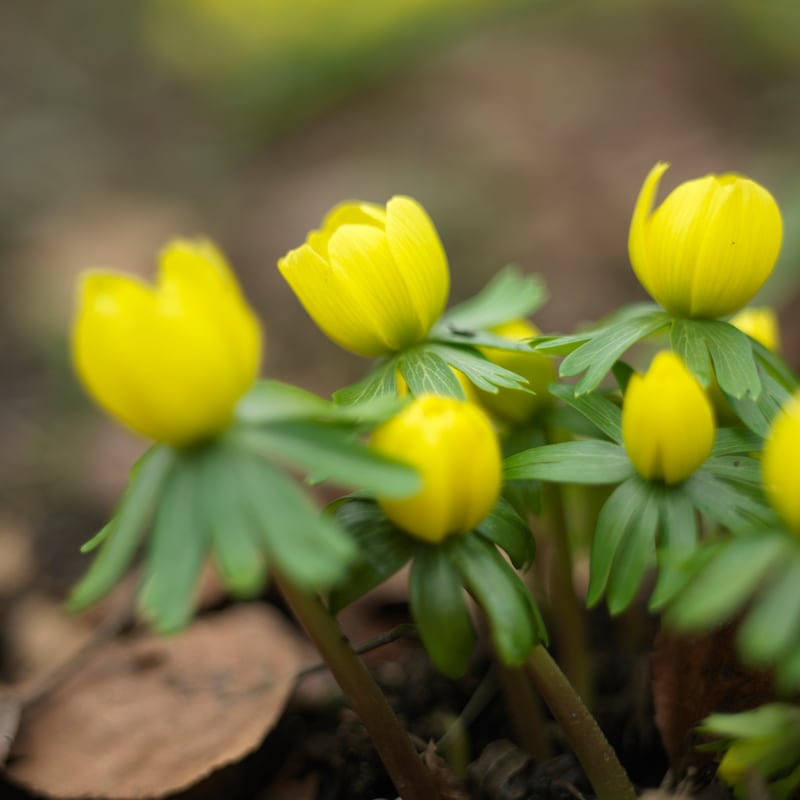
This Week in the Garden
Horticultural fleece is a huge boon for the modern gardener, allowing us to protect plants from early autumn frosts and extend the flowering/growing season. Available from all good Irish garden centres and specialist suppliers such as quickcrop.ie, horticultural fleece comes in different thicknesses/weights– the heavier 30g weight is capable of protecting plants against temperatures as low as minus 3. Another alternative is the water-permeable woven mesh material known as crop-cover climate net (available from specialist suppliers such as fruithillfarm.com) which is more expensive but longer lasting. Just like fleece, this insulating, ultra-lightweight, light-permeable blanket can be thrown gently over plants or suspended above them using supporting hoops/poles.
Remember that late-winter and spring-flowering bulbs aren’t just for borders or pots. There are many varieties that look very lovely planted into lawns, wildflower meadows or sprinkled beneath the skirts of deciduous trees and shrubs where they will naturalise/self seed over time given the right conditions. Examples include the dainty Cylamen coum, crocus, snowdrops, winter aconites, wood anemones, chionodoxa, Scilla siberica, camassias and grape hyacinths as well as many kinds of narcissus.
All of these are available from good Irish garden centres and online specialist suppliers such as mrmiddleton.com at this time of year and should be planted in the coming weeks for a colourful display next spring.
Do this
Are you a rose lover? Then get yourself to Kilkenny Castle next week for the Northern Ireland Garden Heritage Trust’s annual conference, which this year is dedicated entirely to the subject of one of the world’s most beautiful and deliciously perfumed of flowers.
It takes place from Thursday October 3rd to Saturday October 5th and a host of expert guest speakers have been lined up for the event including eco-florist and author Shane Connolly (responsible for flowering up the wedding of England's William Windsor and Kate Middleton), garden historians and authors Brent Elliott, Michael Tooley and Charles Quest-Ritson, Neil Porteous of Mount Stewart, international rose judge Reg Maxwell, rosarian Michael Marriott of David Austin Roses, David S Ingram, plant scientist and former director of the Royal Botanic Gardens in Edinburgh, gardeners Barbara Pilcher and Assumpta Broomfield. Margaret Gormley of the Office of Public Works and others will also be in attendance. Pre-booking is essential; see nihgc.org.
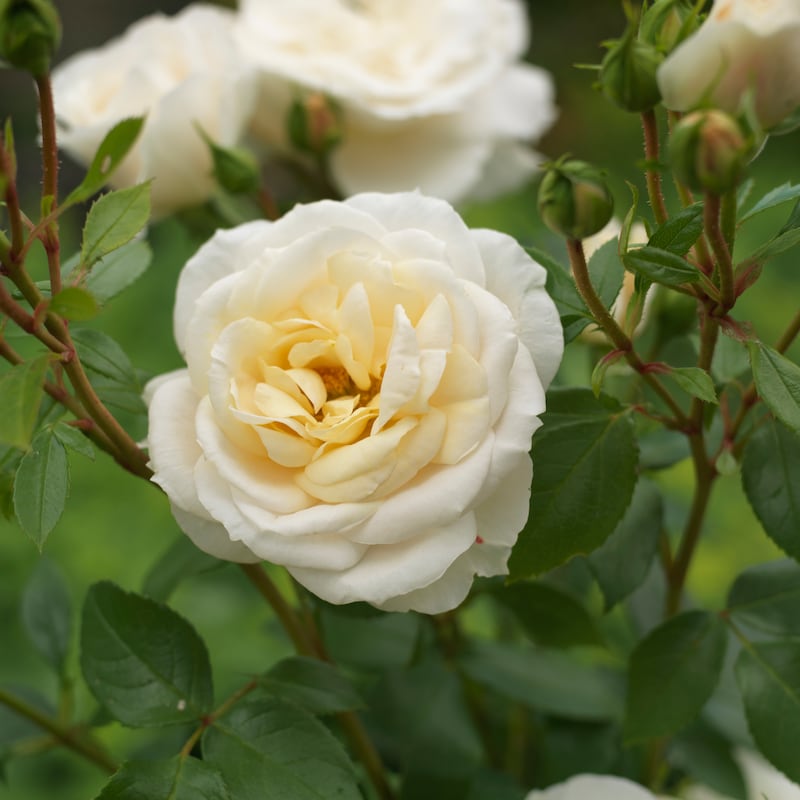
Take part in this
National Tree Day takes place next Thursday October 3rd with various events organised countrywide to celebrate the role trees play in supporting life on our planet. Supported by the Tree Council of Ireland and sponsor Tetra Pak, over 1,000 native tree saplings will also be made available free to primary schools via the website treeday.ie to encourage children to connect with nature and appreciate the role trees play in supporting biodiverse school gardens and combatting climate change.
The website also provides projects, poster downloads, word games, colouring pages and tips for schools and families on recycling, woodland walks etc.
Dates for your diary
Saturday, October 5th (1pm), Woodville Walled Garden, Kilchreest, Loughrea, Co Galway, The Propagator's Diary, a talk/propagation masterclass by horticulturist and plant hunter Rory Newell followed by a talk by dahlia expert and dahlia judge Pat Thornton plus a tour of Woodville Walled Garden's dahlia collection. Admission is €15 and includes light refreshments, pre-booking essential, contact Margarita Donoghue at 087-9069191 or email woodvillewalledgardens@gmail.com.
Wednesday, October 9th (8pm), St Patrick's Recreation Centre, Church Road, Delgany, Co Wicklow, agm plus talk by alpine-plants specialist Valerie Keegan on behalf of Delgany & District Horticultural Society. All welcome.













